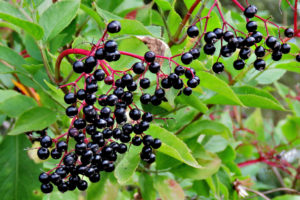ACA – Nutritional Synergy Update #6 (Flu #6)

Elderberry and Licorice act against the flu virus in different ways.
Over the course of the next couple weeks I will share with you some research on the pathophysiology of the flu virus, vaccinations, as well as research-based alternative options we can do to support ourselves during what seems to be increasingly more and more server annual outbreaks of the influenza virus.

~ Sambucus nigra (Elderberry) ~

A standardized liquid extract of Elderberry possesses antimicrobial activity against both Gram-positive bacteria of Streptococcus pyogenes and group C and G Streptococci, and the Gram-negative bacterium Branhamella catarrhalis in liquid cultures. The liquid extract also displays an inhibitory effect on the propagation of human pathogenic influenza viruses. [1]
In one placebo controlled trial Elderberry provided a full cure of the infection in 2-3 days in 93% of the cases whereas the placebo group had a full cure in 6 days in 91.7% of cases (p < 0.001). [2]
In another study the researchers looked at the effect of a concentration of elderberry extract on influenza infected mice. They observed the following three basic effects: 1) a suppression in viral replication in the respiratory fluids, 2) an increase in the level of antibodies in the blood specific for neutralizing the influenza virus, 3) and an increase in secretory IgA in the lungs as well as in feces. [3]
Secretory IgA are immunoglobulins produced by activated B cells in the mucosa that form immune complexes with pathogens thus preventing them from entering into your system. You might think of them as one of your first lines of defense against invading pathogens.
In another randomized, double-blind, placebo-controlled study the researchers looked at “…sixty patients (aged 18-54 years) suffering from influenza-like symptoms for 48 h or less…” They gave 15ml (3 teaspoons) elderberry syrup, or a placebo syrup four times a day for 5 days. “Symptoms were relieved on average 4 days earlier and use of rescue medication was significantly less in those receiving elderberry extract compared with placebo. [4]
~ Licorice ~

Neuraminidase, as we saw at the beginning of this discussion on the flu, is a protein on the viral membrane that prevents viral particles from clumping together as the virus tries to spread.
Tamiflu is a pharmaceutical drug designed to inhibit neuraminidase. It is used widely and indiscriminately throughout the world as one of the first lines of defense against the influenza virus.
The problem is that when we take Tamiflu we metabolize it into another compound called oseltamivir carboxylate, which does not degrade in our feces nor our water supplies. In fact, it has been detected in river water. In the mallard duck populations there is disturbing evidence of Tamiflu resistant strains of influenza A [5-7] This resistance can be transmitted to humans.
As an alternative, extracts from Glycyrrhiza inflata also inhibits neuraminidase. [8]
- Krawitz, C., et al., Inhibitory activity of a standardized elderberry liquid extract against clinically-relevant human respiratory bacterial pathogens and influenza A and B viruses. BMC Complement Altern Med, 2011. 11: p. 16.
- Zakay-Rones, Z., et al., Inhibition of several strains of influenza virus in vitro and reduction of symptoms by an elderberry extract (Sambucus nigra L.) during an outbreak of influenza B Panama. J Altern Complement Med, 1995. 1(4): p. 361-9.
- Kinoshita, E., et al., Anti-influenza virus effects of elderberry juice and its fractions. Biosci Biotechnol Biochem, 2012. 76(9): p. 1633-8.
- Zakay-Rones, Z., et al., Randomized study of the efficacy and safety of oral elderberry extract in the treatment of influenza A and B virus infections. J Int Med Res, 2004. 32(2): p. 132-40.
- Jarhult, J.D., Oseltamivir (Tamiflu((R))) in the environment, resistance development in influenza A viruses of dabbling ducks and the risk of transmission of an oseltamivir-resistant virus to humans - a review. Infect Ecol Epidemiol, 2012. 2.
- Nau, J.Y., [Tamiflu resistance]. Rev Med Suisse, 2006. 2(91): p. 2886.
- Tillett, T., A measure of resistance: detecting Tamiflu metabolite in sewage discharge and river water. Environ Health Perspect, 2010. 118(1): p. A34.
- Dao, T.T., et al., Chalcones as novel influenza A (H1N1) neuraminidase inhibitors from Glycyrrhiza inflata. Bioorg Med Chem Lett, 2011. 21(1): p. 294-8.
In my ACA - Nutritional Synergy Update #7 I will continue discussing the... research regarding Echinacea.




Leave a Reply
You must be logged in to post a comment.